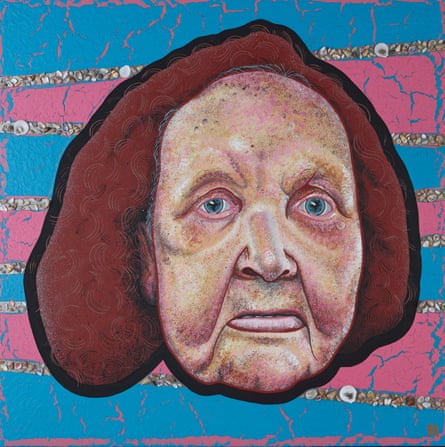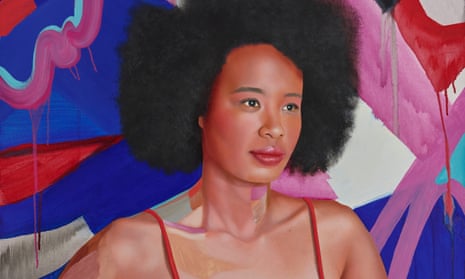The sensation of being alien has been with me as long as I can remember. I think it’s common to many descendants of displaced people. After 10 years in Australia, I’m a citizen but I’m still a settler on someone else’s country. But this was the work of an altogether different power, as subtle as it is violent, and a feeling that is distinctly Australian, integral to a culture built on “not noticing”.
One afternoon while enjoying an exhibition at the Art Gallery of New South Wales, I simply ceased to exist. The Archibald prize claims to feature “a who’s who of Australian culture”. But the finalists for the Archibald portrait prize are a window into how the cultural establishment imagines Australian aspiration and identity. It’s one of Australia’s most prestigious art awards, with $100,000 at stake and the power to transform “outsiders into insiders”. Curious, then, that no representation of a black woman – in many ways, the ultimate outsider – has ever won the prize.
In 97 years, only 15 paintings of women and three of non-white Australians have been winners. Last year, the only trace of us among the finalists was Angela Tiatia’s ethereal self-portrait, itself a powerful exploration of the way more than 60 millennia of women have been rendered as “passive objects” or “exotic others” by the eye of European art. So where are the black women we know in the imagination of Australian culture? I hope this year’s Archibald might conjure up a more satisfying answer.
The global history of art and conventions of portraiture have been dominated by the white male gaze. Black women have been limited to a handful of roles or erased altogether. If our cultural institutions want to forget about black women, perhaps it’s because, as Nora Chipaumire argues, the black female body is “always potentially disruptive”. We are erased to hide the memory of colonialism, its history and its economics. Or shown in ways that demonstrate our inferiority, as servants, as specimens, as sex objects. At the same time “exploitation and abuse have become part of black women’s shared memory and history”.
The way art has been an instrument of colonialism is well documented. However, the global conversation about the connection between culture and violence is changing.

Eighteen months of the #MeToo movement has clearly demonstrated the link between a lack of inclusion and abuse. We’re now undeniably aware of what can happen in boys’ clubs and that we’re complicit if we allow them to persist. #MeToo popularised a discussion about the metrics of structural change – who could have explained an “equity rider” before 2018? None of it is new information but now it’s circulating on an unprecedented scale. The straight white man as de facto representative is just not a good look anymore. The question isn’t “can you be more inclusive?” but “why aren’t you?” Can any publicly funded institution still expect the status quo to continue unchecked?
We didn’t see an equal number of works by women among the Archibald finalists until 2016, and their sitters were still overwhelmingly male. But we’ve got even further to go on race. The recent exhibitions haven’t represented an Australia of the past so much as one that’s never existed.
Thankfully, there are signs that things are beginning to change globally. I can see it in Tiatia’s work, in the disruptive work of Australian artist Boneta-Marie Mabo and her portraits that examine who represents Indigenous women and how. I can see it in American artist Kara Walker’s challenges to the abuse and injustice she sees in the world, rather than replicating it in her art. This feels like progress. As does Amy Sherald’s 2018 portrait of Michelle Obama. Obama wears a brightly patterned dress, reminiscent of quilts sewn by generations of African American mothers during and after slavery. Introducing the idea of “black women’s self-making” and referencing folk art, in stark contrast to the “elitist tradition of portraiture”. Sherald was the first African American woman to receive such a commission – an intentional choice by Obama. “I know the impact that will have on their lives because I was one of those girls,” she said.
It’s time that the many awe-inspiring black women in Australia were included in this reckoning of who’s who. The announcement that Brook Andrew will curate the 2020 Biennale of Sydney was exciting, as was seeing that the Art Gallery of New South Wales introduce an Indigenous advisory board in 2017. Speaking to past finalist and current sitter Tony Albert was equally encouraging. While there’s still room for improvement, he was happy to confirm that there is a noticeable drive for inclusion.
Change can only happen if artists can feel hopeful enough to take part, and it’s been wonderful to see some of the diverse artists and the portraits they’ve entered: Blak Douglas’s vivid painting of Aunty Esme Timbery. Laura Jones’s portrait of her friend Nakkiah Lui. Kim Leutwyler’s bold yet vulnerable image of Faustina Agolley, and 1996 winner Wendy Sharpe’s portrait of Megan Wilding as Blackie Blackie Brown. It feels like a positive trend.
Perhaps this can be the beginning of a snowball, like Gloria Petyarre’s 1999 victory in the Wynne prize that arguably led to record numbers of Indigenous participants. The artists are showing up, I hope the trustees will too. This could be a powerful moment for Australian art. An opportunity for culture to lead an act of shared remembering, waking up to see how white Australia’s past, present and future includes black women.
